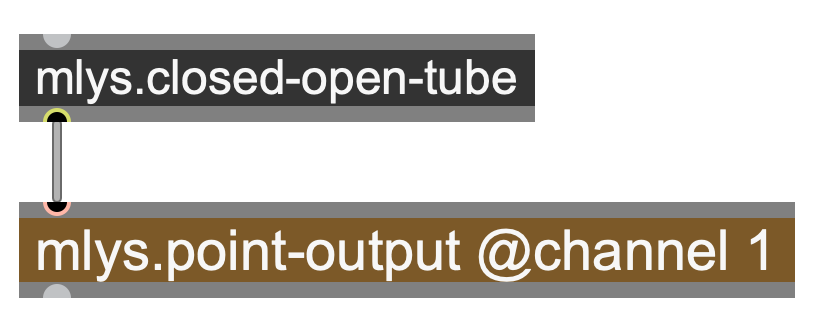Point Output
Description
Creates an audio output from the speed of an access or directly from the value of a controller.
Syntax
An audio output can be created using the following Mlys (Max), mlys.lua, or Lisp syntax:
In Modalys for Max, this object is named mlys.point-output:

----------begin_max5_patcher----------
1510.3oc6Ys0aaaCE9Y6eEr5ojBKGc+R.FP.J1aqnCa8kgkh.ZIFaFHSpQQkDuhte66vKV1Nwwwpy1K.aAvVQTGxuyM9cNT9qCG3Lg+HowAcI52QCF70gCFnGRMv.68CbliernB2nEygQdfO4NmQlGIIOJ0COuZQy3pVLxGEhthgmSP+TK9CRQ0RQqwxhYT1zaDjBoAwfrfwdiP9AI5KIdpKAvXnuXmDqcNkUQjZr8sCRK0PBpgqeryJI4sxkhFZG0LjbQMwfniyH6mNHZv2SJuAVLPstAKkB5jVowmLnyGLvojNmvZnbl5AtVUAfErTs1ro0pM2YR9szJyi6FuoPPqM9LWWzG4kXvyg5beEblTvqpHhqYvyaaHBjYJ56OqtoQ9twiQUDrfgTyXFQPdGZlTV2b4EW7vCOnVmwbwzKliYs3pKhG6eA5b0zulcMSP9iVpfb10NRNup4ZmyUidaKqPBFGhxnRJth9mjyTOPBX94YzFTm.mUxQLtDULCylRPTYCR4Cd24nGnUUnIDjnkgtqsQh3rBxXzuwaQEXFptUhvrEqP.qWuBdIwXCF3tlQXkanRs0kXY+UGPJklfKJ3hRHuCI4H4LB58l068nZr.jTBN3y79Ax8DwBTCddcEYIRePP.AQK3shUp4XPA.ajHaA++83pVh15.6tF1hPJUvrdXDwEv80bJS5BYifWX7RCU8MuVYF3pKUvnWI6RigjBk6RCQC5rB974X2FhRqkjxyUBHUJDBCero9iQ+3iWhTqrcURGkMJW6R6R.kXwThzsKS2rqlyHcRXbPpwgMjd4l+RSShxB0R7sgCW982FN5.vart2AckJTxHUnv8f4HIcsKavbLYZAuhKLh6MNJKIHMJ1KOyKLOHXDLTXTtmedhWZVTneXpZH+3j0kCV49vEscpH+WjJpuTPVGyZ7aCblhoZFIPQeFkzOqbqeR6UcN7ANCy0eAD9w6HPAdTUnILQofnruCF9vs6VSdI2ZCcJreRwwuu+WuCD0f8QWVKvw4TtoHFcUCoBTOfVQUpMFktCueZX956ORheKrMI3DtOItm6StweUgZqa1lGC4vifkCkh9xwIdWTwgxGPAAByU1NgrGg0fXyk79uq5nSVA0cIMMtTlqsfuaMugJsaZT4Zdwdl+TIRwYKAnapfN7hy02NUeUxoexZykJbKUMpIWXB2AFAiRSxBS8SVWNBDWjzBqnpZcJkIvKKMINOoK0Apk2HcgnSySRftE5kZaiWQXSkydxf.eowIk87DvOnC8eBh7edUfGh7THxaUsMFysq0E8zs3sTDAtj113s052aJi++503i1QVd7FjWuQpw6cBIuh5K4UvQpTjJaAqnBe8fkgRJMs2LR4GcBI1zJxS1MU.b7B69+vHus3d+kMM8k6b18lqY7sx8bbBN5BF6SUCaHJKxDn76cHJ6+qY71olgpZw+EqXDrVCvAu9IDSMm3H7sPmuomvZGA8s1Q3Kz3avwpe2xEfdPKrurvO1VIopWflO5JyaUIDEs5jkUTFof2xjqYa6HpGjo43LTcpX+dGiRN1wnMdOhgOKjrxOzEOztCCbgJ6QaTZa53DXrugxW+L89Ze8VNT4q4jiOI05cUzmZLKISEjUrjyU9XMQ1nsdf9Rd6DnUgSIql+tpam7lqM3nSHSleeYxhbNEDV+JU8phU6TWRXkm2W1Jaj0dL9r7dyVEdRYqd9O5wJmv1Xqxy+mQRAZjDP907eIZVwfnkeu2du0Zev1bzMDFdh8TB8yyNAnbbLFq0J0pgNU3I+9ZZCQM9lldCuUTrb4rmHBsxXfNAkTFdUCscmGE4sAti5MPY6AP4G.bR2CbhO.3jrG3jd.vIdeBPgG.fhNQNtv8.mnC.NA6ANGB+l5WGV0.6tiPGBfBNQQHe+8ImK3Pfj2oxj9tvwvthqqumHVVeRCATB4NSuPYiz2RYla0Gi2QPtuqQOckYGr.JqHgZJsBSQsGSLs2nO9sf0paUzenx3.H0kmTE.apwF6PWEa32F92.2RCFu.
-----------end_max5_patcher-----------
😉 Click the button above to copy/paste a full example to Max (New From Clipboard) ☝️
local s1 = create_object{ kind="mono-string",name="s1" }
local s1acc1 = create_access{where=s1,name="string1Access1",position=0.35}
create_point_output{ where=s1acc1,
name="ptoutput3",
channel=3,
gain=1.1,
selector={1,3,5,7} }
(make-point-output reference)
;;; or:
(make-point-output reference channel gain selector)
Parameters
A Point-Output takes from one to four arguments:
- reference: reference to the access or the controller to which the "loudspeaker" should be attached.
- channel: (optional) which output channel to send the samples to (default 0, i.e. channel 1).
- gain: (optional) value or controller to scale the amplitude of the samples (default 1).
- selector: (optional) if provided, it is used to select an individual mode (or modes) to output (default 0 = all modes). If the reference is a controller, the selector is used to specify the dimension which will be output (default 0).
This function lets you output the speed of an access (i.e. the sound generated by that access), or the value of a controller.
The channel parameter sets the output channel for this point-output. The number of output channels is automatically set using the highest value given for this parameter, unless overridden by the (set-number-of-channels ... ) function.
The gain can either be a value or a controller to set or dynamically modify the amplitude of the output samples.
For an object's access, the selector, when set to 0, outputs the sum of all modes. To output an individual more, you should provide a numerical value, where 1 corresponds to the first mode, 2 to the 2nd, etc... You can also provide a list for this parameter in order to output multiple modes. All output modes are scaled by the controller as a unit, so if you want multiple modes with independent amplitude controllers, you should make multiple point-outputs.
For a controller, the selector corresponds to the dimension whose value will be output.
Discussion
Manually setting the number of output channels is optional. Modalys will automatically determine the number of output channels based on the channel arguments provided to the Point Output functions that are used in the script. (The make-point-output command additionally has optional arguments to set which channel to direct the output to.)
★